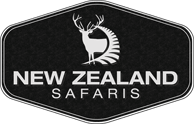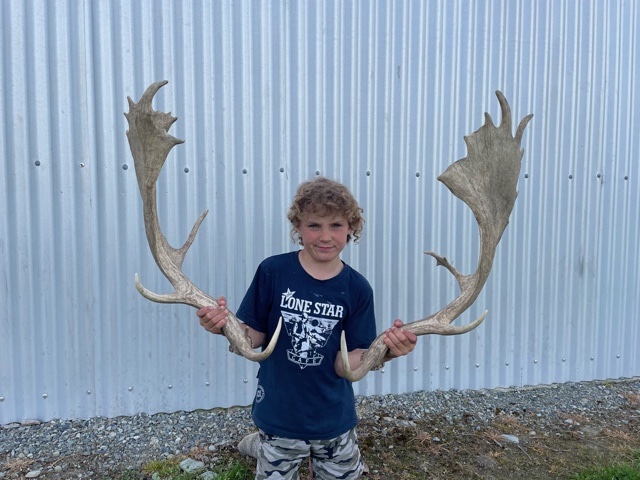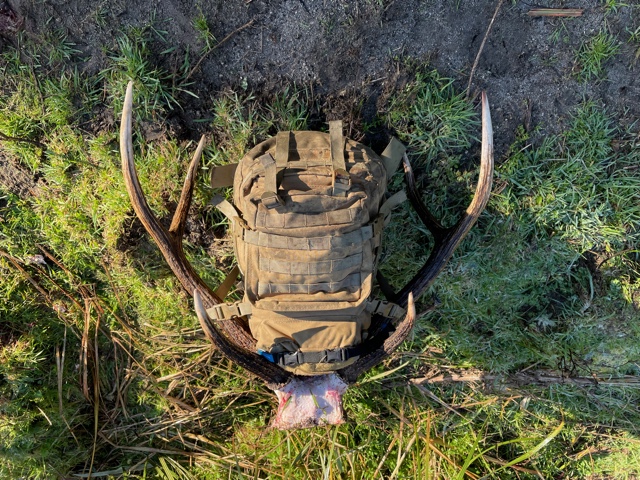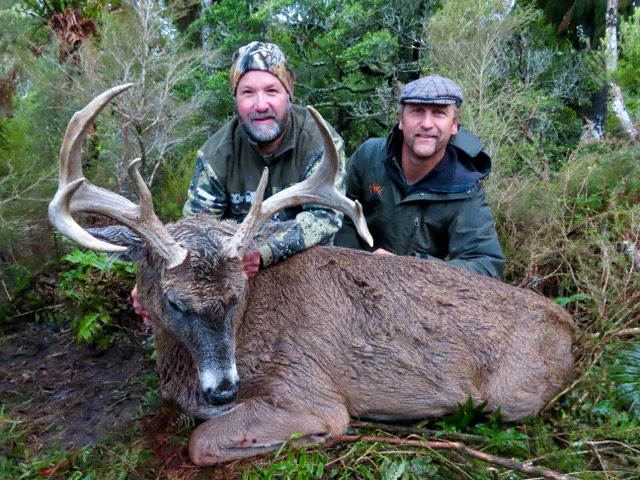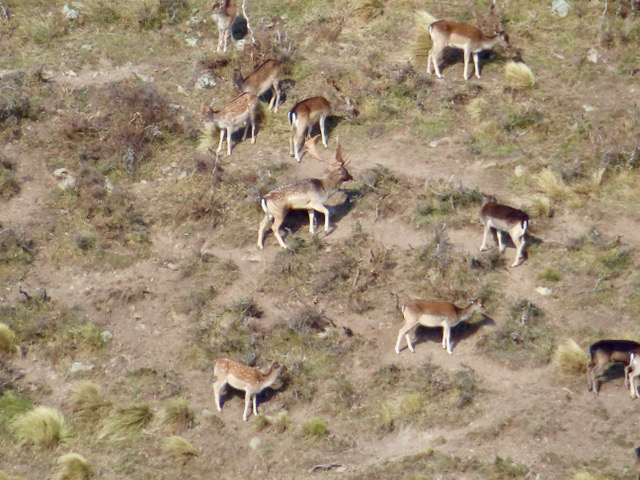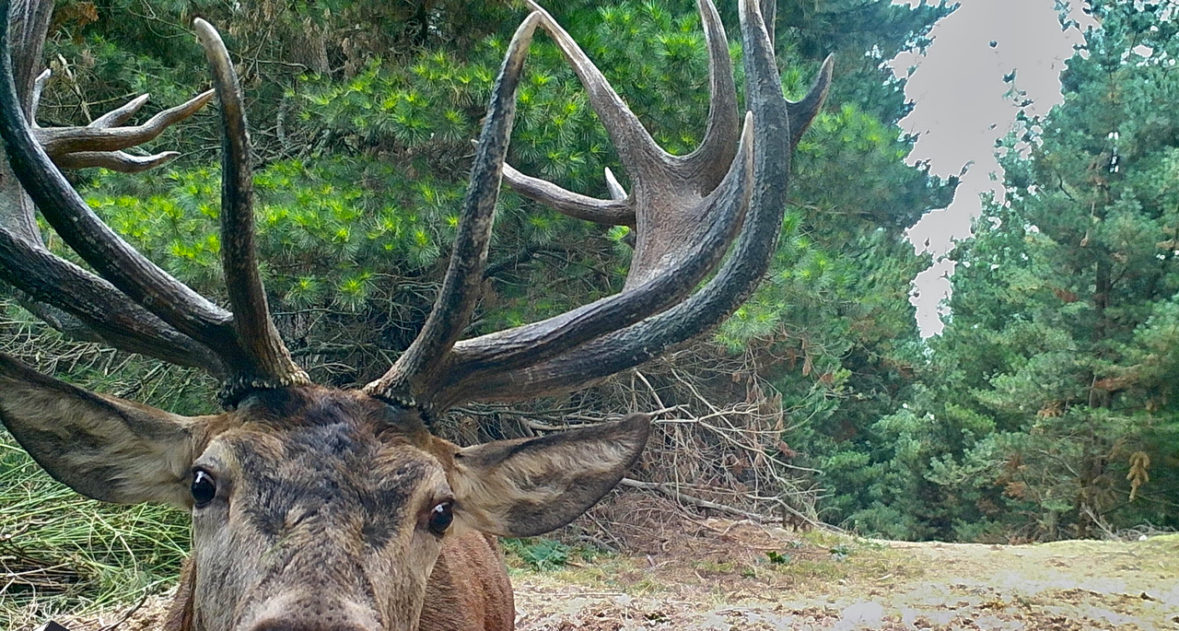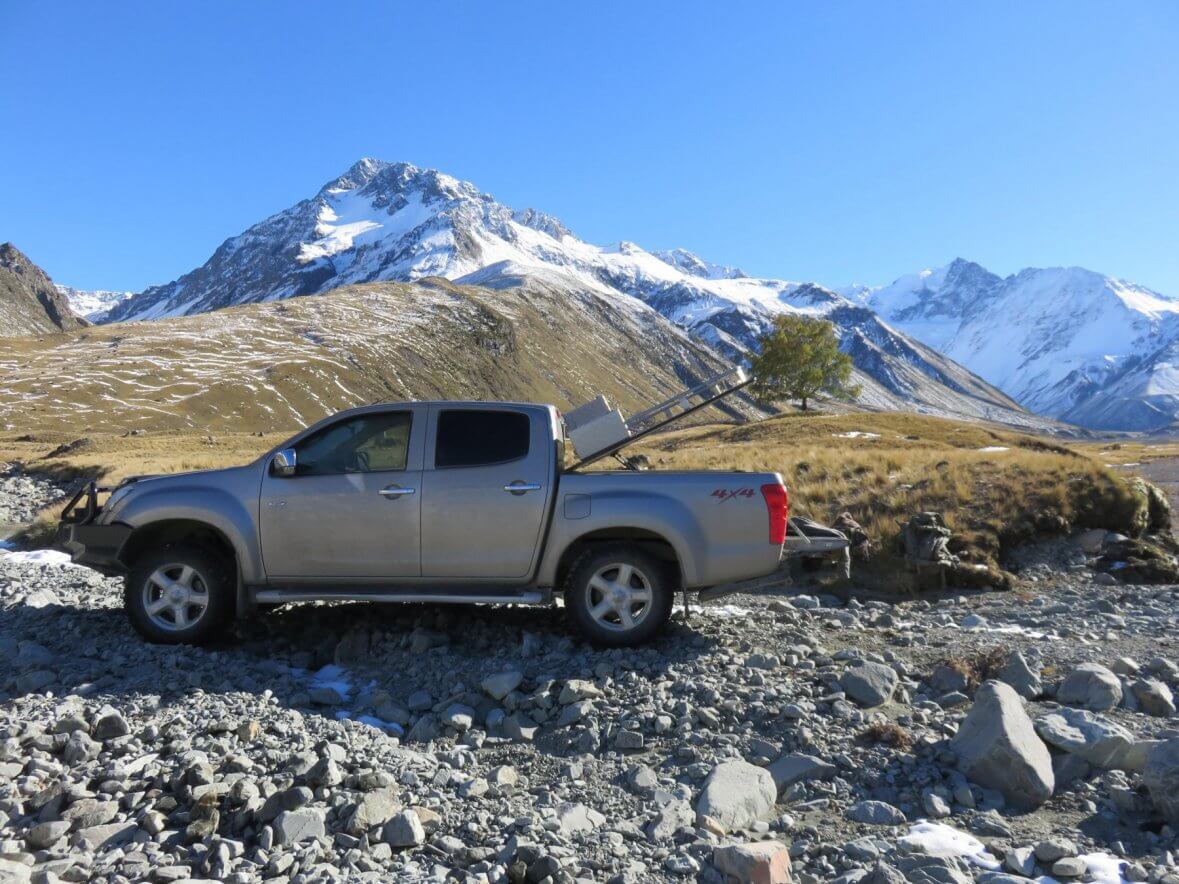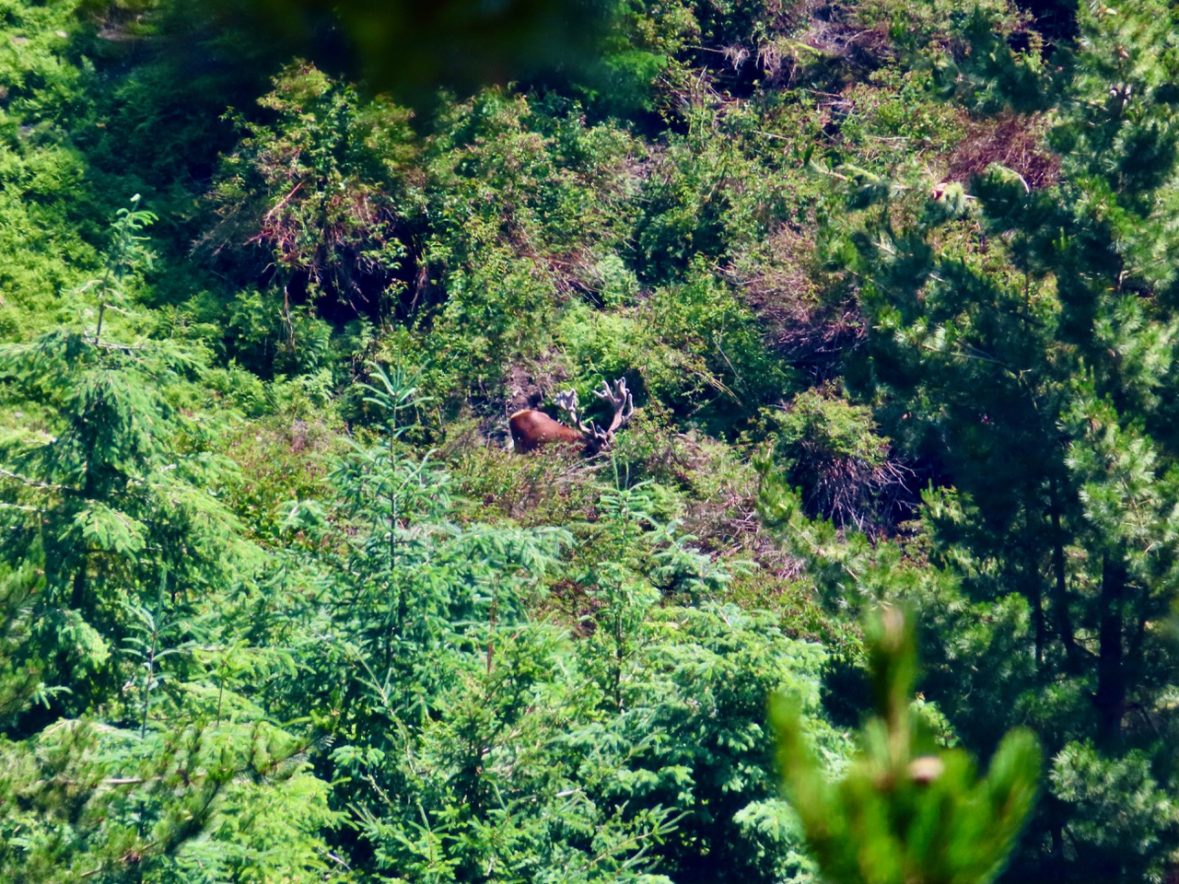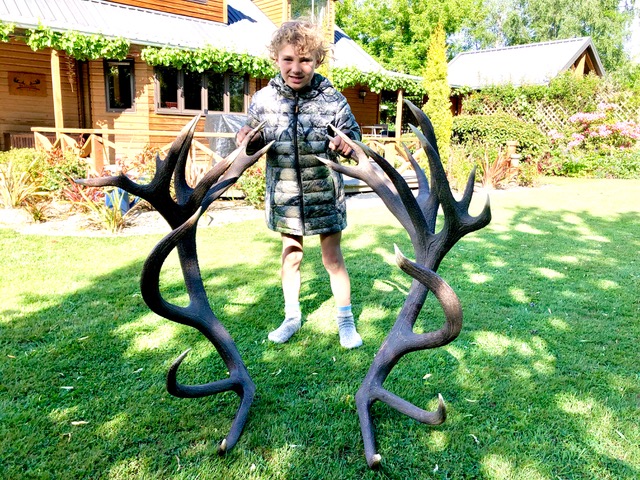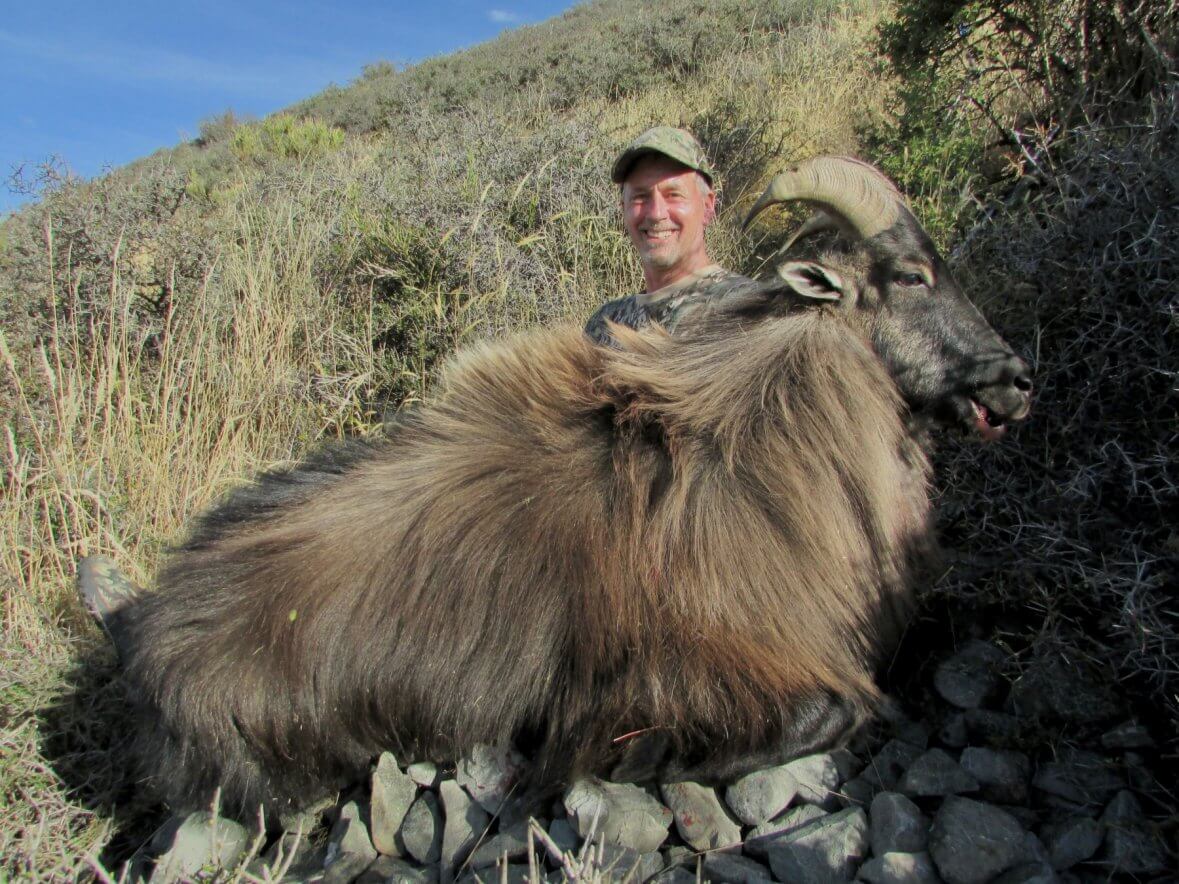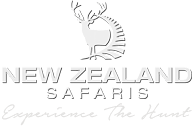Well we’re getting to the tail end of the year again. Summer is all but here in New Zealand with all the deer growing out their velvet antlers. We have picked up a few so far including this giant set of Elk antlers at over 53 inches long on the main beam and 12 inch mass I would think this set would go well into the 400 inches+ class. Also this huge set of Fallow buck antlers from our local `big Bucky Buck` which will be interesting to see if he cracks the legendary 300 inches mark.
Sambar deer hunting in New Zealand is one of the most challenging wild and free range hunts we have in the country. Larger in body size than Red Stags Sambar stags are more spend most of their lives in heavy cover seldom venturing into the open. Sambar Stag are typical in antler formation having 3 points on either side but with very heavy mass, rough pearling on the antlers and dark. The females will have one fawn a year and tan brown in colour when alerted Will make a hong alarm. Sambar deer in New Zealand will rut from late May-mid August which is one of the longest mating seasons for animals in New Zealand which is very typical of tropical deer that were introduced into New Zealand. Sambar deer hunting in New Zealand is predominantly on private land or forestry, most Stags are hunted at night with a light or with dogs, Jim Gibson owner of New Zealand Safaris is one of the very few New Zealand Hunting Outfitters that offer wild free ranging Sambar deer hunts on private land in the traditional spot and stalk hunting method.
Whitetail deer are only in the South Island of New Zealand, which has the only herds of white-tail deer in the southern hemisphere. The history of New Zealand Whitetail started in 1901 when a group of deer were released in the Takaka Valley Nelson. For reasons not documented or known this liberation failed, like the Mule deer and Black tail deer that were also released around the same time. But all was not lost when in 1904 the World’s Fair was held to commemorate the 100th anniversary of the Louisiana Purchase, this amazing show in St. Louis, Missouri, was a sight to behold. Covering more than 1,200 acres and playing host to nearly 20 million visitors over a seven-month span, it was up to that point the most spectacular such event in history, and it remains the largest world’s fair ever held today. Nearly all of the then-45 states had lavish displays of their resources, as did around 60 other countries from all over the globe.
What makes the 1904 World’s Fair relevant to New Zealand is that of the many exhibits on display there, one included a herd of whitetails. Reportedly they had been trapped in deep snow in New Hampshire and then taken to St. Louis, though precisely when, how and by whom they were captured and transported no one today seems certain. What we do know is that at the time there were probably only around a half-million whitetails on earth, a crowd likely had never seen one. Apparently President Theodore Roosevelt decided to give these whitetails to New Zealand. And so, at some time in late 1904 or early 1905, a ship carrying them headed down the Mississippi River from St. Louis, bound for New Zealand. Remarkably, of the 22 deer that went onto the ship, 18 of them — four bucks and 14 does — made it across the Pacific alive which was a 12,000 mile journey by boat. On Saturday March 26 nine of the Virginian deer were sent to Pegasus Sound, Stewart Island, and the remaining nine were forwarded to Rees Valley, Lake Wakatipu in the lower part of the South Island. Whitetail deer in New Zealand have 2 main well established herds, and are doing well although the mainly land herds are bigger in body and antler than those on Stewart Island both herds are smaller in trophy potential than those in North America due to the lack of genetic diversity. Today thanks to a private land owners passion for these deer New Zealand Safaris has exclusive access to hunting Whitetail deer on this privately owned hunting property. This herd of New Zealand Whitetail come from both the Stewart Island herd, and Wakatipu herd which has given them a very unique trophy potential. With huge bodies and heavy mass of main beams the bucks have never been harvested until this year when an Australian hunter who regularly comes over took an amazingly old 11 yr old Buck coming in at approx 130 inches of antler. With further development of the property and managing trophy potential of the Bucks this herd is on target to set new records of trophy Whitetail deer in New Zealand.
New Zealand Fallow deer rut is in full swing. Unlike many other deer species Fallow Bucks will have a large rut pad they will hold, with the female does coming in to get serviced. Fallow Bucks make more of a croak like a frog which is very entertaining, yet not to underestimate these Bucks as often an explosive fight can lead to death of the looser. When you have high numbers of Fallow deer on properties in New Zealand you will have low numbers of Red deer. Our main wild and free ranging property that has Fallow deer on it has only ever seen one Red deer move through it. New Zealand Safaris is based right in the centre of the largest herds of Fallow deer in New Zealand. Not only do we offer hunts for trophy Bucks on private land, but we also do management hunt on the does and cull bucks to keep the numbers down, hunt for a natural meat source, and to manage the genetics to try and keep the lesser Bucks from breeding. We can hunt Fallow deer all year with the New Zealand Fallow deer being typically late March-End of April.
New Zealand Red Stags are on the move. It’s March 2021 and the red Stag rut in the central South Island is in full swing. The Hinds (females) are starting to show up on our trail cameras which has seen increased activity up in the forestry as the temperatures start to cool down these sees animals starting to move more looking for new grasses and a partner, or two. The first roaring of our Red Stag in this area is typically in February as unlike many places around the country its alot cooler up in the trees the Stags tend to rub off their velvet earlier and wallow causing a shift in their hormones. Most of our deer are left with a natural breeding programme, we cull out stags that do not have trophy potential and make sure we have out minerals over the year to maintain good health. Excess females are lured out in winter down onto the farm where they become part of the the farming operation which makes sure we have a good balance in our hunting area as well as maintaining feed through the colder months.
We had in the middle of last year clarity on taxation on different parts of how an Outfitters business is run. In particular the experience of the hunt and trophy components. Under the professional guides association we have been following this with a few members attending discussions so that we are now up to speed on how this will affect our businesses. When a hunter is look at doing a New Zealand hunt it is important now that they make sure the Outfitters details all costs involved in their hunt, including local taxes. All international hunters weather they take an animal out of the country or will be subject to the new taxation laws. Many Outfitters will be adding this onto the end of the hunt so you must make sure this is discussed up front as I have heard many of the part time and lower priced guides are still not aware of these changes. New Zealand Safaris has now as we have done in the past incorporated any adjustments into our new prices so that our clients will have a complete and inclusive prices with no additional charges except for flights and expediting of trophies to keep our hunts simplified.
A White Stag (or white hind for the female) which also occurs in Fallow deer is a white-coloured red deer, explained by a condition known as leucism that causes its hair and skin to lose its natural colour. Leucism is a rare genetic trait that causes a reduction in the pigment of an animal’s hair and skin. The natural colour of the red deer ranges from dark brown to red. They are often thought to be albinos. But unlike albinos, who have red eyes, deer with leucism have normal colouring in their eyes. It is distinguished biologically from albinoism in that it causes a reduced pigmentation in all skin types, and not just melanin.The white has played a prominent role in many cultures’ mythology. Hunters of old pursued the miraculous stag, not because they expected to kill it, but because it led them in the joy of the chase to new and fresh adventures, and so to capture happiness. You may look on the White Stag as the true spirit of Scouting, springing forward and upward, ever leading you onward to leap over difficulties, to face new adventures in your active pursuit of the higher aims of scouting. Jim Gibson owner of New Zealand Safaris has been managing one of his properties to now have one of the most talked about white deer populations in the world. The Stags on this property like many tend to have dark antlers with white tips making an amazing contrasts in colour We offer limited hunts on White Stags in New Zealand each year so as to assure we these stags pass on their genes. The first White Stag harvested was aged 12 years old which is testament to only taking mature old deer.
As we move into January Red Stag antlers are still in velvet, with most Red Stags around 80% grown out they generally go into hard antlers late January. With it being very warm in January/February Red Stag antlers tend to start getting itchy so they will start rubbing as soon as the velvet is hard and stops becoming sensitive. Red Stag antlers at this time of year in Velvet can weigh around 10-15 kg (22-33 lb) per side.
Shed hunting red stag antlers in New Zealand is one of those new adventures that has not taken off as in North America mainly due to most of the larger deer populations are on private land. Shed hunting on our private properties is a lot of fun especially this year, with a limited hunting season there were a lot of surprises. From huge shed antlers of Red Stag to finding dead old Stags that must have past due to age of fighting during the rut. New Zealand has a reputation of the finest quality of red Stag in the world from typical to non typical deer. The Sheds can weigh as much as 15 lbs per side and there is now high demand from buyers of red stag shed antlers to use them for everything from sliced up dog chews to knife handles, chandeliers, lamp holders and table legs. Red Stag antlers are typically not as long as Elk, with our Stags averaging around 35 inches in length.
Tahr in New Zealand are being targeted and culled on government land due to the minister Eugene Sage from the political Greens Party to wipe out these amazing animals. DOC (Department of Conservation) under Eugene’s order have begun killing tahr in Aoraki/Mt Cook and Westland Tai Poutini National Parks by way of helicopter gun ships before undertaking consultation with the hunting sector. This will change tahr hunting in New Zealand.
“The 1993 Plan was put in place as a best-guess at a time when little information was really known about tahr in our alpine environment to manage wild animals of crown land. The intention stated within the Plan was for it to be reviewed and updated as more science and information was developed which has never happened.” “DOC have never undertaken the proper research on vegetation impacts, herd densities and the contributions of recreational and commercial hunting that are necessary to inform future management. Instead they focus on short-term culling programmes like what is happening right now that pit the various stakeholders against each other.”
Hunting Tahr for the foreseeable future on government land will now be extremely challenging, and trophy Bulls near impossible to locate as the helicopters are currently shooting all Tahr they come across including Bulls. Jim Gibson from New Zealand Safaris has been for the last 14 years been guiding international clients on privately owned wilderness land exclusive to New Zealand Safaris. These areas have more so now than ever before become a very important refuge for not only managing the Tahr on these properties, but the Bulls have the opportunity to grow mature (6yrs old+) and have the ability for good feed without being constantly hunted by local hunters and helicopters. Giving them a high economic value to the land owners has meant that they can cohabitate in certain parts with their Merino Sheep and cattle in the mountains becoming an important part of their income, thus also encouraging management of these animals which includes reducing some of the female numbers for meat when required. Tahr hunting in New Zealand is set to change forever, hunters and more part time Outfitters will find it very difficult to even see a mature Tahr in the foreseeable future on government land, with mature Bull Tahr on private land likely to increase in value due over culling these privately owned Wilderness areas are set to play a major conservation role to the species that are already considered under threat in the Himalayas.
